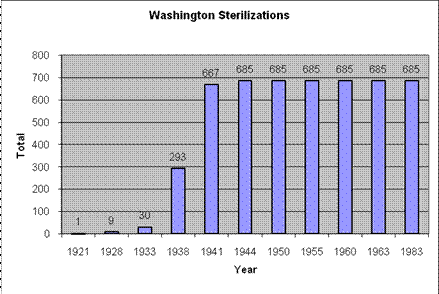Washington
Number of Victims
There were 685 people sterilized in the state of Washington. Almost 75% of the victims were women, and the majority was deemed mentally ill. A significant number of those labeled as mentally deficient were also sterilized. A small number of rapists or habitual criminals also appear to have been sterilized.
Period during which sterilizations occurred
Sterilizations occurred in Washington between 1921 and 1944. The eugenics program was implemented quite slowly at first in the 1920s. The numbers increased significantly in the mid and particularly the late 1930s. The final sterilization took place by 1944. Sterilization was declared unconstitutional in 1942 (Paul, p. 526).
Temporal Pattern of sterilizations and rate of sterilization

Passage of Laws
Washington was the second state to pass a sterilization law. The first law was passed in 1909. It was punitive in nature and referred only to habitual criminals and those who were convicted of rape, for whom sterilization would be a punishment (Laughlin, p. 6, Landman, p. 56). The Washington Supreme Court upheld this ruling with a case in 1912, sentencing a man convicted of rape to sterilization (Laughlin, p. 149).
A more comprehensive law was passed in 1921. This law included a much broader group in state institutions (see below) and was in place until 1942, when it was invalidated (Paul, pp. 525-526).
Groups identified in the Law
The 1909 law was aimed only at habitual criminals and those who had committed crimes of rape (Paul, p. 525). Later, those who were in institutions and “feebleminded, insane, epileptic, habitual criminals, moral degenerates, and sexual perverts” were identified in the law (Laughlin, p. 6; Landman, p. 56; see also Paul, p. 526).
Process of the Law
Under the 1921 law, those inmates in state institutions would be selected and have their cases examined by the Board of Health, subsequent to superintendents of state institutions having given quarterly reports about those who could be candidates for sterilization (Landman, p. 56). Those approved by the Board of Health could be sterilized, with a notification prior to the operation begin performed. Individuals had fifteen days to protest the ruling and no sterilization could be carried out while the protest was being reviewed. As soon as an order from the superintendent of the Board of Health was received, sterilization could be carried out (Laughlin, pp. 16-17).
Groups Targeted and Victimized
Those targeted were often those deemed socially degenerate. These included “reform-school girls, welfare moms, the retarded, gays, and the physically disabled” (Berger). Many homosexuals who faced imprisonment faced sterilization under the 1909 law (Boag, p. 207).
Major Proponents:
Bethenia Owens-Adair was a physician and avid supporter of eugenics throughout the Northwest. She advocated sterilization as a form of punishment, as it was used in the 1909 sterilization law (Boag, p. 207; see Oregon for more information).
Many activists supporting sterilization laws were
Progressive women who lobbied on behalf of the 1921 law (Brown at al.).
“Feeder Institutions” and institutions where sterilizations were performed
It appears that all individuals who were sterilized were those living in state institutions (Laughlin, p. 15). Washington State Penitentiary at Walla Walla and the State Reformatory at Monroe were prisons in which a small number of prisoners were chosen for sterilization (Laughlin, p. 91).
The names of the other institutions are unknown and cannot be ascertained with certainty. Goldsmith/Reed’s report of Washington’s state institutions of 1912 identifies the above state prisons as well as two state asylums for those with mental illness, state schools for dead and the blind, and two places for those deemed mentally deficient and/or deviant: the State Institution for the Feeble-Minded at Medical Lake, and the State Training School at Chehalis.
 (Photo origin: Maple Lane High School, available at http://www.rochester.wednet.edu/MLHS/history.htm)
(Photo origin: Maple Lane High School, available at http://www.rochester.wednet.edu/MLHS/history.htm)
The State Training School at Chehalis housed delinquent youth whose offense was “incorrigibility.” In 1913 girls became their separate institution, at Maple Lane (Ott). It continues to operate today as a high school (Maple Lane High School).
 (Photo origin: Lakeland Village, available at http://www1.dshs.wa.gov/DDD/lakeland.shtml)
(Photo origin: Lakeland Village, available at http://www1.dshs.wa.gov/DDD/lakeland.shtml)
The State Institution for the Feeble-Minded at Medical Lake changed its name to Custodial School in 1933, subsequently renamed Lakeland Village, and due to overcrowding, a second custodial school was opened in Buckley, subsequently renamed Rainier State School (Washington State Department of Social and Health Services, “A History”). Lakeland Village operates today as a provider of services for developmentally disabled persons (Washington State Department of Social and Health Services, “Lakeland”).
Bibliography
Boag, Peter. 2003. Same-sex Affairs: Constructing and
Controlling Homosexuality in the Pacific Northwest. Berkeley: University of
California Press.
Brown,
Sherrie, et al. 2008. “Powerpoint
Presentation.” Course on Disability and Society: Introduction to
Disability
Studies, Fall 2008, University of Washington. Available at
<http://courses.washington.edu/intro2ds/Lecture%20materials/Woiak-May15-eugenics--2.PPT>.
Berger, Knute. 2003. "Breed and Weed."
Seattle Weekly (April 16). Available at <http://www.seattleweekly.com/2003-04-16/news/breed-and-weed.php
>
Goldsmith, May; and Anna Reed. 1912. Report
of Conditions in the State Institutions of Washington. Olympia: Boardman.
Landman, J.H. 1932. Human Sterilization: The History of the Sexual Sterilization Movement.
New York: MacMillan.
Laughlin, Harry H. 1922. Eugenical Sterilization in the United States. Chicago: Psychopathic
Laboratory of the Municipal Court of Chicago.
Maple Lane High School. “History of Maple Lane High
School.” Available at < http://www.rochester.wednet.edu/MLHS/history.htm>.
Ott, Jen. 2008 “Washington State Reform School
opens in Chehalis on June 10, 1891.” HistoryLink.org. Available at < http://www.historylink.org/index.cfm?DisplayPage=output.cfm&file_id=8647>
Paul, Julius. 1965. "'Three Generations of Imbeciles
Are Enough': State Eugenic Sterilization Laws in American Thought and
Practice." Washington, D.C.: Walter Reed Army Institute of Research.
Washington State Department of Social and Health Services. “A History of Human Services.” Available at <http://www.dshs.wa.gov/geninfo/aboutdshs/3history.shtml>.
Washington State Department of Social and Health Services. Division of
Developmental Disability. “Lakeland Village.” Available at <http://www1.dshs.wa.gov/DDD/lakeland.shtml>.